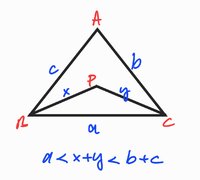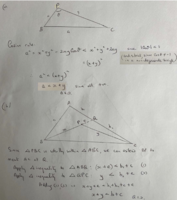You are using an out of date browser. It may not display this or other websites correctly.
You should upgrade or use an alternative browser.
You should upgrade or use an alternative browser.
Proof for this theorem?
- Thread starter miregal
- Start date
For the first part, a<x+y - you could google "triangle inequality". You could attempt proving e.g. using the cosine rule.
For the second part: x+y<b+c, the problem is not fully specified. You need some extra information e.g. are [MATH]\angle [/MATH]PRC and [MATH]\angle [/MATH]PCR both acute angles or does [MATH]\bigtriangleup[/MATH]PRC have to be wholly within [MATH]\bigtriangleup[/MATH]ARC? etc...
For the second part: x+y<b+c, the problem is not fully specified. You need some extra information e.g. are [MATH]\angle [/MATH]PRC and [MATH]\angle [/MATH]PCR both acute angles or does [MATH]\bigtriangleup[/MATH]PRC have to be wholly within [MATH]\bigtriangleup[/MATH]ARC? etc...
HallsofIvy
Elite Member
- Joined
- Jan 27, 2012
- Messages
- 7,760
First is should be obvious that angles PRC and RCP are smaller than angles ARC and ACR. Then apply trigonometry to right triangles ARQ and PCQ where Q is the foot of the perpendiculars from A and P to RC.
miregal
New member
- Joined
- Dec 22, 2020
- Messages
- 29
I didn't know the theorem's name thanks for that. For the second part, because it is said that P is a point inside the triangle (sorry for not mentioning it), x+y will be less than b+c.(If [MATH]\bigtriangleup[/MATH]PBC has to be wholly within [MATH]\bigtriangleup[/MATH]ABC (as it is drawn), then the second part can be proved using the triangle inequality).
I think I was misreading the B as a R.
Yes the extra information is needed to see what we can 'take for granted' from the picture that they have drawn.
You are right x+y<b+c, but the question is how might you prove it?
The proof must work for a set of triangles like this, containing obtuse angles:

(That's why it's important to know that P simply has to be within [MATH]\bigtriangleup[/MATH]ABC and that there is no special restriction on the angles).
You are right x+y<b+c, but the question is how might you prove it?
The proof must work for a set of triangles like this, containing obtuse angles:

(That's why it's important to know that P simply has to be within [MATH]\bigtriangleup[/MATH]ABC and that there is no special restriction on the angles).



